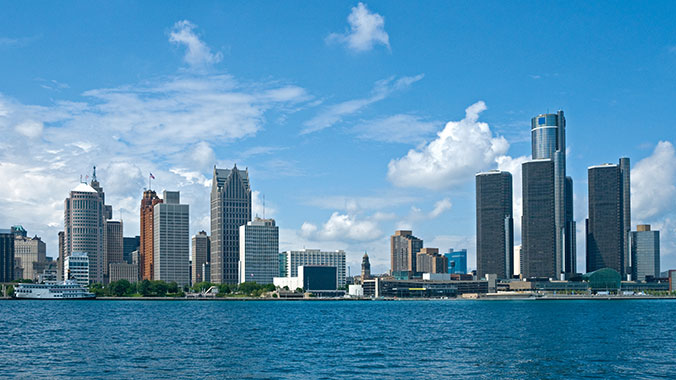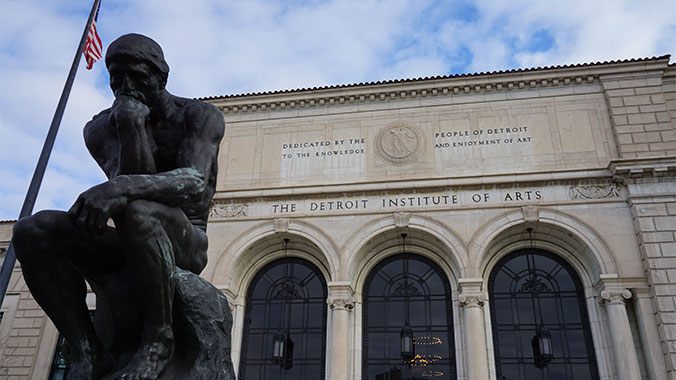Michigan
Signature City Detroit
Program No. 21851RJ
Detroit has the nation's only floating post office and created its first stretch of paved road. Come join our experts for an insider's look at this fascinating city.
Itinerary
While we make every effort to ensure the accuracy of our published materials, programs are typically advertised more than a year prior to their start date.
Read More.
While we make every effort to ensure the accuracy of our published materials, programs are typically advertised more than a year prior to their start date. As a result, some program activities, schedules, accommodations, personnel, and other logistics occasionally change due to local conditions or circumstances. Should a major change occur, we will make every effort to alert you. For less significant changes, we will update you during orientation. Thank you for your understanding.
Duration
6 days
5 nights
What's Included
12 meals (
5B, 4L, 3D
)
2 expert-led lectures
10 expert-led field trips
1 performance
An experienced Group Leader
5 nights of accommodations
Taxes and customary gratuity
Road Scholar Assurance Plan
Day
1
Check-in, Registration, Orientation, Welcome Dinner, Lecture
Location:
Detroit, MI
Meals:
D
Stay:
Hilton Garden Inn Detroit Downtown
Activity Note
Hotel check-in available from 3:00 p.m. Remember to bring your nametag (sent previously).
Afternoon:
Program Registration: 3:00 p.m. After you check in and have your room assignment, join us at the Road Scholar table to register with the program staff, get any updated information, and confirm the time and location of the Orientation session. If you arrive late, please locate your Group Leader and let them know you have arrived. Orientation: 5:00 p.m. The Group Leader will greet everyone and lead introductions. We will review the up-to-date program schedule, discuss roles and responsibilities, logistics, safety guidelines, emergency procedures, and answer questions. We will learn from a series of local experts who will give lectures and lead field trips. Program-related travel and transfers will be via private motorcoach unless noted otherwise. Meals will feature local cuisine in a variety of settings. Periods in the schedule designated as “Free time” and “At leisure” offer opportunities to do what you like and make your experience even more meaningful and memorable according to your personal preferences. The Group Leader will be happy to offer suggestions and show you how to use the free downtown train: The People Mover. Program activities, schedules, personnel, and indicated distances or times may change due to local circumstances/conditions. In the event of changes, we will alert you as quickly as possible. Thank you for your understanding.
Dinner:
At the hotel.
Evening:
After dinner, we’ll enjoy a lecture by a local expert on the history of Detroit.
Day
2
The History of Detroit
Location:
Detroit, MI
Meals:
B,L
Stay:
Hilton Garden Inn Detroit Downtown
Activity Note
Getting on/off a motorcoach; driving under 10 miles total with multiple stops, approximately 3 hours riding time. Walking and standing for up to 1.5 hours during walking tour. Walking .3 miles to dinner.
Breakfast:
In the hotel restaurant.
Morning:
We will begin the day with a walking exploration of the city with a local expert, who will provide us with an up-close look at downtown Detroit. Here, we will see how an area once dominated by heavy industry has given way to a beautiful waterfront. We will be amazed by the wide array of architecture styles ranging from mid-19th-century to modern and learn how the city has undergone many renaissances. We will feel the energy of a downtown on the rebound – one that – until recently – was known as a ghost town. We’ll return to the hotel for a short break then board a motorcoach and ride to lunch.
Lunch:
Not to be missed, we'll visit a Detroit institution for lunch: Buddy's Pizza – serving up famous Detroit-Style pizza! In order to try a bit of it all, we will be served a family-style meal.
Afternoon:
We’ll board the motorcoach with our local expert for an extended exploration of Detroit. In the city’s recent past, stories of crime and decline dominated the media. Now dubbed the “comeback city,” its turnaround is making news. We will rediscover Detroit’s fascinating history and experience the revitalization as we travel aboard a motorcoach throughout the heart of the Motor City and soak up the sights, sounds, and scents of this compelling place. Along the way, our local expert will shed light on numerous factors that led to the dramatic rise and fall of this former industrial powerhouse that put the world on wheels, and reveal who’s behind the revitalization. Crown jewels, legendary landmarks, and hip new happenings - we'll see it all!
Dinner:
This meal has been excluded from the program cost and is on your own to enjoy what you like. We will walk to Greektown, where you can choose from its many eateries.
Evening:
At leisure.
Day
3
Ford Estate, African American History, Ford Piquette Plant
Location:
Detroit, MI
Meals:
B,L
Stay:
Hilton Garden Inn Detroit Downtown
Activity Note
Getting on/off a motorcoach; driving 40 miles, approximately 2 hours total riding time. Walking and standing for 1.5 hours in the morning. Ford House tour includes 45 – 60 minute walk around the estate: pathways are asphalt, gravel, cobblestone, grass and dirt as well as stairs. Walking and standing up to 2 hours in the afternoon.
Breakfast:
At the hotel.
Morning:
We’ll start the day with a drive along Lake Shore Road to the town of Grosse Point to visit the Ford Estate. The Edsel & Eleanor Ford House illustrates the home life of this prominent American family who were cultural, social, and economic leaders of their times. The comfortable yet artfully designed and decorated mansion was the centerpiece of the Ford family’s life. We'll hear the inside stories and visit the mansion and gardens with an expert.
Lunch:
Not to be missed, we'll visit a Detroit institution for lunch: American Coney Island – serving up Detroit’s famous hot dogs! They also serve salads, gyros, chili, and other carnival-inspired favorites. Please note that this venue's vegetarian options are very limited.
Afternoon:
We will then depart for a field trip to the Charles Wright Museum of African American History. One of the world’s oldest independent African American museums, “The Wright” dedicates itself to exploring the legacy of African Americans from Harriet Tubman to the Tuskegee Airmen to Aretha Franklin. We'll then transfer to the Ford Piquette Avenue Plant Museum for a guided exploration. The Ford Model T car was assembled at the Ford Piquette Avenue Plant. It is recognized as one of the most significant automotive heritage sites in the world. We'll return to the hotel via motorcoach.
Dinner:
This meal has been excluded from the program cost and is on your own to enjoy what you like. Your group leader will be happy to make suggestions or show you how to take the People Mover to a different part of downtown.
Evening:
At leisure.
Day
4
Rouge Factory, Henry Ford Museum, Greenfield Village, Jazz
Location:
Detroit, MI
Meals:
B,L,D
Stay:
Hilton Garden Inn Detroit Downtown
Activity Note
Getting on/off a motorcoach six times; driving about 30 miles, under 1 hour total riding time. The Ford Rouge Factory exploration is a walk long a ramp above the factory floor, a 0.3-mile walk for the full circuit. Walking and standing for up to 2 hours at a time; be sure to wear your most comfortable shoes.
Breakfast:
At the hotel.
Morning:
We will head out via motorcoach to Dearborn for a full day of exploration and discovery of Henry Ford as a collector of American History and as the innovator of the factory assembly line. We will view the actual Rouge Factory in action and examine America’s memorabilia in the collections of The Henry Ford Museum through self-guided tours. Presenters stationed throughout the tour at key locations who can answer questions. Please note, it can be loud in the Rouge Factory. If you have sensitive ears, it is a good idea to bring earplugs.
Lunch:
We will receive meal vouchers to be used at any of the dining options at the Henry Ford complex.
Afternoon:
We’ll continue on to explore Greenfield Village. With the included village ride pass, we can ride the steam locomotive, horse-drawn Carriages, the Model T, and the 1913 Carousel. We will wander through the seven historic districts that illustrate America’s history. We’ll then return to the hotel via motorcoach.
Dinner:
While at unique local restaurant, depending on the venue's calendar, we will hope to listen to a live jazz pianist as we eat.
Evening:
At leisure.
Day
5
Music and History of Motown, Detroit Institute of Arts
Location:
Detroit, MI
Meals:
B,L,D
Stay:
Hilton Garden Inn Detroit Downtown
Activity Note
Getting on/off a motorcoach; driving 40 miles, approximately 2 hours total riding time. Walking and standing for 1.5 hours in the morning, up to 2 hours in the afternoon.
Breakfast:
At the hotel.
Morning:
We will engage in a discussion with a local Detroiter who grew up in the culture of Detroit’s music. During this lecture, we will learn about the history of Motown. We will explore “Hitsville U.S.A.,” the small house where music history was made – now the Motown Museum – as the recording studio where The Temptations, Marvin Gaye, Diana Ross and the Supremes, Stevie Wonder, and so many more artists came to record the hit songs that changed the way America thought of music.
Lunch:
A voucher is provided for lunch on arrival at the Detroit Institute of Arts.
Afternoon:
We will take in the highlights of the Detroit Institute of Arts on an expert-led visit. Then, we'll have some time to explore more of the exhibits on our own. Among the top art collections in America, notable works include Mexican artist Diego Rivera’s Detroit Industry fresco cycle, which Rivera considered his most successful work, and Vincent van Gogh’s Self Portrait, the first Van Gogh painting to enter a U.S. museum collection.
Dinner:
At a local restaurant. Share favorite experiences and enjoy camaraderie with new Road Scholar friends during our farewell dinner.
Evening:
At leisure. Prepare for check-out and departure in the morning.
Day
6
Program Concludes
Location:
Detroit, MI
Meals:
B
Activity Note
Hotel check-out by 11:00 a.m.
Breakfast:
At the hotel.
Morning:
Following breakfast, we will have a brief program wrap-up with our Group Leader. This concludes our program. If you are returning home, safe travels. If you are staying on independently, have a wonderful time. If you are transferring to another Road Scholar program, detailed instructions are included in your Information Packet for that program. We hope you enjoy Road Scholar learning adventures and look forward to having you on rewarding programs in the future. Don’t forget to join our Facebook page and follow us on Instagram. Best wishes for all your journeys!
Please select a day to update the map
Map details are not available for this location.







